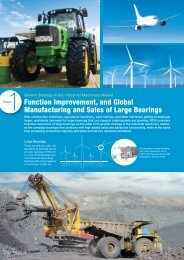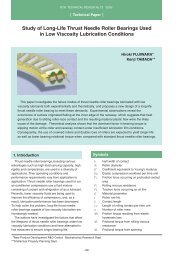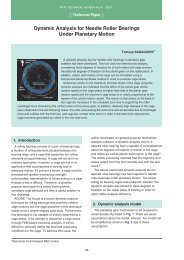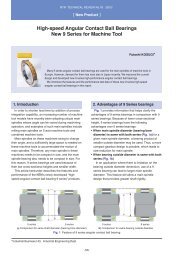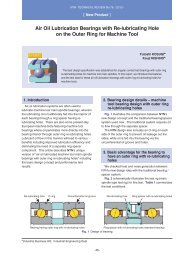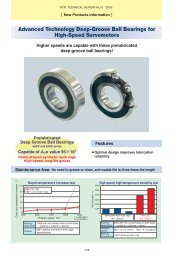Special Issue; Products for Industrial Machinery - NTN
Special Issue; Products for Industrial Machinery - NTN
Special Issue; Products for Industrial Machinery - NTN
Create successful ePaper yourself
Turn your PDF publications into a flip-book with our unique Google optimized e-Paper software.
Atmospheric Control Method <strong>for</strong> JIS-SUJ2 Carbonitriding Processes<br />
Table 1 Equipment used <strong>for</strong> atmospheric measurement<br />
Equipment Measurement Measurement technique<br />
IR gas concentration analyzer<br />
Mirror-surface cooling dew-point recorder<br />
Zirconia sensor <br />
Thermal conductivity gas analyzer<br />
Thermal conductivity detector<br />
CO/CO2 concentration<br />
H2O concentration<br />
O2 concentration<br />
H2 concentration<br />
Undecomposed NH3 concentration<br />
Non-dispersion IR absorption<br />
Optical dew point<br />
Zirconia oxygen partial pressure analyzer<br />
Thermal conductivity<br />
Gas chromatograph (carrier: helium)<br />
Vestibule<br />
Heating<br />
chamber<br />
Cooling blast air<br />
chamber<br />
Heating<br />
chamber<br />
A<br />
B<br />
Oil<br />
quenching<br />
tank<br />
C<br />
Fig. 1 Heat treatment furnace<br />
pieses were determined by electron beam analysis (2<br />
m spot diameter, 2m intervals between measuring<br />
points) with an Electron Probe Micro Analyzer<br />
(EPMA). The test pieces were placed in the center of<br />
the experimental furnace <strong>for</strong> carbonitriding prior to this<br />
measurement. A sample piece was cut, as illustrated<br />
in Fig. 3, from each test piece that underwent<br />
carbonitriding (after quenching). Then, the nitrogen<br />
concentration distribution on each sample piece was<br />
measured on the cut surface, beginning at the<br />
midpoint at the outer diameter and proceeding toward<br />
the bore.<br />
To determine the amount of nitrogen penetration of<br />
each test piece, the nitrogen concentration distribution<br />
obtained from analysis were integrated in the direction<br />
to where the nitrogen concentration approached zero<br />
(Fig. 4). The total amount of nitrogen penetration was<br />
converted into a weight, assuming that the specific<br />
gravity of the original material was 7.85 x 10 -3 g/mm 3 .<br />
2.3 Definition of carbon activity<br />
One very important factor that can influence the<br />
atmosphere <strong>for</strong> carbonitriding is the carbon activity,<br />
which determines carbon penetration. The author<br />
employed the Boudouard reaction <strong>for</strong> calculating<br />
carbon activity. The equilibrium reaction is defined by<br />
expressions (1), (2) and (3) below:<br />
Fig. 2 Base gas feeder<br />
(A: Supply from pure gas tank, B: mass flow controller,<br />
C: gas mixer)<br />
Table 2 Chemical composition of JIS-SUJ2 used (wt%)<br />
C Si Mn P S Ni Cr Mo Cu<br />
0.99 0.26 0.44 0.012 0.006 0.08 1.46 0.03 0.15<br />
38<br />
30<br />
10mm<br />
5mm<br />
Area analyzed by EPMA<br />
Cross-section<br />
of test piece<br />
Outside<br />
diameter<br />
Inside<br />
diameter<br />
Fig. 3 Test specimen dimensions and scanning position<br />
1.2<br />
1.1<br />
1<br />
0.9<br />
0.8<br />
0.78wt%<br />
0.7<br />
0.6<br />
0.5<br />
0.4<br />
0.3<br />
0.2<br />
0.1<br />
0<br />
-0.1<br />
0 0.2 0.4<br />
Depth from surface mm<br />
Amount of nitrogen penetrationg/mm 2 =7.8510 -3 g/mm 3 0.002mm0.78wt%100<br />
Fig. 4 Definition of nitrogen penetration content<br />
0.6<br />
-45-




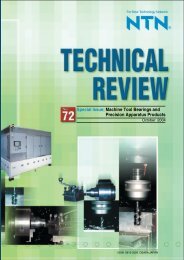
![[New Product] Unit Products for Office Equipment - NTN](https://img.yumpu.com/27154451/1/184x260/new-product-unit-products-for-office-equipment-ntn.jpg?quality=85)
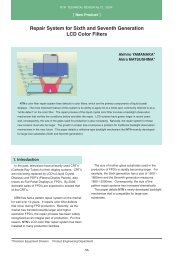
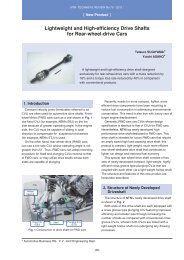
![[New Product] Development of Oil-impregnated Sintered ... - NTN](https://img.yumpu.com/27154427/1/184x260/new-product-development-of-oil-impregnated-sintered-ntn.jpg?quality=85)

